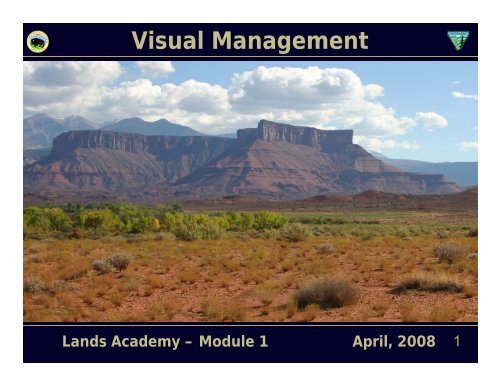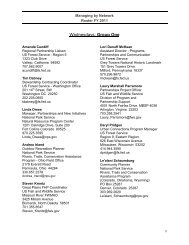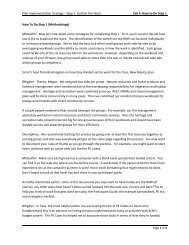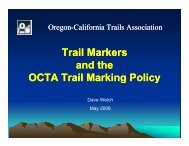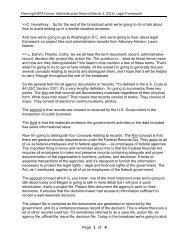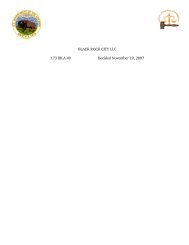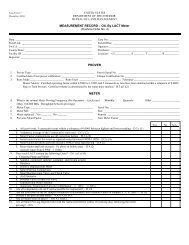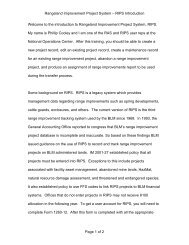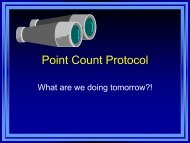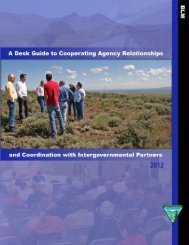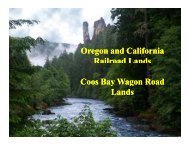UNIT 1 - National Training Center
UNIT 1 - National Training Center
UNIT 1 - National Training Center
Create successful ePaper yourself
Turn your PDF publications into a flip-book with our unique Google optimized e-Paper software.
Visual Management<br />
Lands Academy – Module 1 April, 2008<br />
1
Overall Objectives Page 2<br />
After completing these units, you will be able to:<br />
• Describe basic principles and concepts of visual system<br />
• Analyze a characteristic landscape<br />
• Deploy siting and design techniques to minimize contrast<br />
• Conduct a simulation to visualize a project’s impact<br />
• Collaborate with proponents -planning, design,<br />
construction and rehabilitation phase.<br />
2
Useful Websites Page 2<br />
Copy of all of slides from today All PowerPoint for this class<br />
• http://www.ntc.blm.gov/krc/resource.php<br />
BLM’s <strong>National</strong> Visual Resource Management web site<br />
• http://www.blm.gov/nstc/VRM/index.html<br />
Best Management Practices for Oil & Gas Development<br />
• http://www.blm.gov/bmp/Technical_Information.htm<br />
Forest Service’s Built Environment Image Guide:<br />
• http://www.fs.fed.us/recreation/programs/beig/<br />
Images of Existing and Proposed Lands Projects<br />
• Google.com<br />
Best Management Practices – General Fossil Energy<br />
• http://www.fossil.energy.gov/programs/oilgas/environment/publi<br />
cations/BMPHandbookFinal.pdf<br />
3
The Why of Visuals –Exer. 1A<br />
• Why should visual aspects of a project be a<br />
concern to professional realty/special l use<br />
specialists Tables 1 & 2<br />
• What are benefits of good scenery<br />
management to community and region<br />
Tables 3 & 4<br />
• Whom should you consult with if you have<br />
questions on visual aspects of project<br />
Tables 5 & 6<br />
4
Units for Today<br />
Unit 1 – Overview of Two Systems<br />
Unit 2 - Looking at Landscapes<br />
Unit 3 – Project Planning and Visuals<br />
Unit 4 – Design Fundamentals and Strategies<br />
Unit 5 – Environmental Factors<br />
- Contrast Rating Process<br />
- Writing EAs<br />
5
The Why of Visuals –Report out<br />
Why should visual aspects of a project be a<br />
concern to professional realty/special use<br />
specialists Tables 1 & 2<br />
6
Unit 1 Page 4<br />
• Landscapes are legacy<br />
Why Manage<br />
• We management a lot of land<br />
• Diversity of landscapes<br />
<strong>UNIT</strong> 1<br />
7
BLM/FS manages lands with inherent scenic value…<br />
<strong>UNIT</strong> 1<br />
8
Public lands and forests contain a variety of scenic landscapes.<br />
<strong>UNIT</strong> 1<br />
9
<strong>UNIT</strong> 1<br />
10
<strong>UNIT</strong> 1<br />
11
<strong>UNIT</strong> 1<br />
12
<strong>UNIT</strong> 1<br />
13
The scenic significance of many landscapes is cultural or historic.<br />
<strong>UNIT</strong> 1<br />
14
Lands provide a place to escape and enjoy the beauty of nature.<br />
<strong>UNIT</strong> 1<br />
15
BLM and Forest Service lands are the backyard of many<br />
communities.<br />
<strong>UNIT</strong> 1<br />
16
Unit 1 Page 4<br />
Multiple Uses on Lands Create IMPACTS<br />
• Growing demands<br />
• Projects have impacts<br />
• Poorly design projects reflect negatively<br />
Growing needs for what types of projects<br />
Where are these projects located<br />
<strong>UNIT</strong> 1<br />
17
Lands are also valued for many other activities and uses.<br />
Increasing Demand for:<br />
-Communication Sites<br />
-R-O-Ws<br />
-Recreation<br />
-Mineral Development<br />
-Wind Energy<br />
<strong>UNIT</strong> 1<br />
18
If not carefully designed, activities have the potential to:<br />
• modify character of landscape<br />
•reflect on BLM image<br />
• affect visitor experience and community quality of life<br />
• cause project delays through protest, appeals<br />
• increase long term costs due to restoration needs<br />
<strong>UNIT</strong> 1<br />
19
<strong>UNIT</strong> 1<br />
21
<strong>UNIT</strong> 1<br />
22
Page 4<br />
Visual Resource Management<br />
Scenery Management System<br />
• Identify visual (scenic) values<br />
• Minimize visual impacts to landscape character<br />
• Use a language to “describe landscapes”<br />
• Lend objectivity – common terminology<br />
<strong>UNIT</strong> 1<br />
23
Record benefits - addressing visual concerns Page 5<br />
Tbl Tables 3&4R Report Out<br />
What are benefits of good scenery<br />
management in community and<br />
region<br />
<strong>UNIT</strong> 1<br />
24
Benefits<br />
If it looks good<br />
Then project has been<br />
successful in blending with<br />
the characteristic landscape<br />
<strong>UNIT</strong> 1<br />
25
Benefits if carefully designed...<br />
<strong>UNIT</strong> 1<br />
26
Benefits<br />
<strong>UNIT</strong> 1<br />
27
Benefits<br />
<strong>UNIT</strong> 1<br />
28
Benefits<br />
<strong>UNIT</strong> 1<br />
29
C. Authority - Managing Scenery Pg 5<br />
<strong>UNIT</strong> 1<br />
30
C. Legal Obligations Page 5<br />
<strong>National</strong> Environmental Policy Act (NEPA) 1969<br />
• Assure aesthetically pleasing surroundings<br />
• Require agencies use a system based on environmental design<br />
arts for planning and mitigation<br />
BLM Policy<br />
The Federal Land Policy and Management Act 1976<br />
• Protect scenic values<br />
• Maintain an inventory of scenic values<br />
• Minimize damage to scenic values<br />
<strong>UNIT</strong> 1<br />
31
BLM Policy for Scenery<br />
BLM Policy: Manual Section 8400: Visual Resource<br />
Management (1984)<br />
• Basic stewardship responsibility<br />
• Each program has responsibility<br />
Realty spec/special uses spec. - recommendations<br />
Managers – make decisions<br />
i<br />
• Develop Visual Resource Management classes thru planning<br />
• Use Contrast Rating Process for all projects<br />
<strong>UNIT</strong> 1<br />
32
FS Policy for Scenery Mgt. Pg 6<br />
Agricultural Handbook No. 701 – Landscape<br />
Aesthetics<br />
• Tool for integrating benefits, values, desires,<br />
• Orderly inventory, analysis, & management<br />
• Common terminology, guidelines<br />
• Techniques for monitoring<br />
<strong>UNIT</strong> 1<br />
33
Pg 6<br />
The Scenery Management System (SMS)<br />
is a tool for integrating the benefits, values,<br />
desires, and preferences regarding<br />
aesthetics and scenery for all levels of land<br />
management training<br />
34
Procedures for Managing Scenery<br />
Land Use Planning Level<br />
• Variety of Landscapes<br />
• Maintain an Inventory of Visual Values<br />
• Assign Visual Objectives<br />
•Handbook 8410:<br />
• Inventory & VRM Classes<br />
• [ land use planning ]<br />
<strong>UNIT</strong> 1<br />
35
BLM Policy for Managing Scenery<br />
Activity/ Project Level<br />
• Analyze the landscape<br />
• Use design techniques to reduce contrast<br />
• Manage activities to Meet VRM objectives<br />
• Handbook 8431:<br />
• Contrast- Rating<br />
• [ project analysis/ evaluation ]<br />
<strong>UNIT</strong> 1<br />
36
Principle Components VRM System: Pg 5<br />
<strong>UNIT</strong> 1<br />
37
Assessment<br />
Your manager called. He needs six talking talking<br />
points on our scenic management system. The<br />
Crystal City county commissioners have invited<br />
him to their monthly luncheon. A 69 kv powerline<br />
is proposed thru Crystal canyon. Mixed ownership<br />
They are concerned about preserving the scenic<br />
views from Crystal City on BLM/FS land.<br />
Prepare 4-6 talking points for your manager<br />
Process: Work in teams of two – have 5 min.<br />
38
Record benefits - addressing visual concerns Page 5<br />
Tbl Tables 5 & 6 Report Out<br />
Whom should you consult with if you<br />
have questions on visual aspects of<br />
project<br />
<strong>UNIT</strong> 1<br />
39
Summary<br />
• We manage lands with inherent “scenic values”<br />
• Multiple uses create visual impacts<br />
• We have legal obligations & guidelines<br />
– NEPA, FLPMA<br />
– 8400 Manuals/ Agi Handbook No. 701<br />
• We have visual systems in place to:<br />
– Identify visual values<br />
– Minimize visual impacts<br />
– Provide objective analysis<br />
40
Available <strong>Training</strong><br />
Visual Resource<br />
Management<br />
Course 8400-05<br />
Nov 3-7, 2008<br />
Las Vegas<br />
FS Regional<br />
Sessions<br />
41
Unit 1 provide the background on why we<br />
manage the landscape, benefits, and legal<br />
obligations.<br />
Next, lets look at the landscape and discover<br />
the tools and techniques<br />
End Unit One<br />
42


